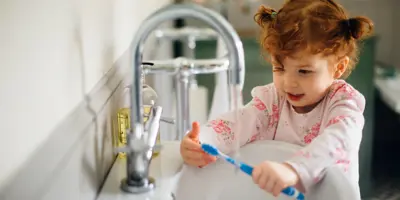4 people found this helpful

You’re always looking out for others, planning, checking in, keeping things running. But when was the last time you paused to check in with your own health? Your body sends quiet signals, even in the bathroom. The shape and consistency of your stool, even its colour, offer important clues about your wellbeing. From understanding what a healthy stool shape looks like to tips for achieving a normal stool colour, think of this as your reminder: tuning into your body isn’t extra. It’s essential.
Our downloadable poo chart is a quick and easy guide to help you tell your Type 1 from your Type 7. Plus, discover more about your health, hydration, and diet with 5 facts about stool colour and information about these 7 types of stool:
- Separate, hard lumps
- Lumpy and sausage-like
- Sausage shape with cracks in surface
- Soft, smooth snake or sausage
- Soft blobs with clear-cut edges
- Mushy consistency with ragged edges
- Liquid consistency with no solid pieces
What is a healthy stool consistency?
A healthy stool gives a good sign that everything in your bowel is working nicely, but what is a healthy stool? The best stool consistency is:
- Consistent
- Soft-to-firm texture
- All in one piece
What is a healthy stool passing routine?
Whilst everyone is different, there are a few signs that you have healthy stools other than the stool shape:
- Stools should be regularly passed.1
- Passing stools once or twice a day is considered healthy.
- The healthy minimum is three times a week.
When you know your own routine – and what’s normal for you – it’s easier to notice when something’s off. Catching those shifts early? That’s a quiet but powerful form of self-care. So, take the bathroom break and take your time. It’s not just a pause. It’s a check-in with yourself.
What is a healthy stool? Other signs you have good poop
Your poo routine and your stool shape are obviously good to know, but here are a few other signs you have a normal stool:
- Colour: The colour of your stool can tell you a lot about your poop. A normal stool should be brown in colour.
- Ease of passing: We’ve all been there, feeling a little like it’s hard to poop. However, this isn’t normal. A healthy stool should be painless to pass.
- Smell: Much to the disgust of many, a great way to tell that you have a normal, healthy stool is the fact that it is strong-smelling.
Stools can change colour or consistency for innocuous reasons, like dietary causes or taking medication, but they can also change because of an underlying medical condition.2 Being familiar with the usual shape, size, colour, texture, and regularity of your poo is the key to knowing if there might be an issue with your health and when it’s a good time to contact a medical professional for advice and reassurance.
You deserve comfort – even in life’s least glamorous moments. Choose toilet paper that’s luxuriously soft and reliably strong, like Cushelle Quilted. It’s thicker, more absorbent, and designed to treat you (and your behind) with the care you so generously give to everything else.
What is normal stool colour?
The colour of your stool can tell you a lot about what’s happening in your body. As you now know, normal stool colour is any shade of brown, so this is an easy sign to tell you have healthy stools.3 Some medications and foods can have an impact on the shade of your poo, as can some illnesses and medical conditions.
Dr Leena Sinha says:“If you notice a significant difference or change in your normal stool colour or consistency, especially if you also have other symptoms such as abdominal pain, it is important to see your GP for further advice and management.”
Here are some colours and causes, to help you decipher if you have a normal stool colour:
- Green stools. This could be a sign that your stools contain bile. Often this is a sign that food is moving through the intestine quickly – like in diarrhoea. Other causes of green poop include iron supplements and your diet. This includes green leafy vegetables and green food colouring in ice lollies or drinks.
- Yellow stools. This can indicate excess fat – this is particularly the case if the stools smell foul and have a greasy texture, too. There might be excess fat because of malabsorption due to a condition like celiac disease, or issues with producing bile or enzymes because of pancreas diseases. Request medical tests if this is something you’re experiencing.
- Black stools. This colour can be caused by black liquorice, black stout, iron supplements or bismuth subsalicylate from medicines like Pepto-Bismol. However, it can also be due to bleeding in the stomach or other parts of the upper gastrointestinal tract – particularly if the stools look like coffee grounds, or are sticky and tarry, and smell foul. You should always contact your doctor for advice if you have black stools.
- Red stools. You might find beetroot, tomato soup/juice, red berries or red food colouring/gelatine could be to blame for a reddish tinge – and your stool colour will return to brown once the food has moved through. That being said, it could also be a sign blood might be present – this time in the rectum, large intestine, or other parts of the lower intestinal tract, possibly due to haemorrhoids. Always get in touch with your doctor to investigate further if you experience red or maroon stools.
- White stools. If your stools are white, clay-coloured, grey or very light in colour, this can indicate a lack of bile, which might be caused by a bile duct obstruction or gallbladder or liver issues. However, it could also be down to taking large amounts of anti-diarrheal medication and those containing bismuth subsalicylate. Speak with your GP to get to the root of the cause.2,3,5
Did you know? It’s not just stool colour that can tell you about your health. The colour of your urine can also give you an indication of what’s going on in your body. Check out our urine colour chart for more!
Different types of poop
The Bristol Stool Chart categorises our stools into seven different types of poop:
- Type 1: Separate hard lumps. This stool shape is often described as being like rabbit poo, or marbles which are usually hard to pass. If your poo is like this, it could suggest that you’re suffering from severe constipation. You can help the situation by drinking more water, but it is sensible to think about seeing your doctor.
- Type 2: Lumpy and sausage-like. A bit like a bunch of grapes, the second type on the stool chart is made up of joined-up lumps of poop. This can point to mild constipation. As with type 1, if you get on top of your hydration, you should be able to help it improve.
- Type 3: Sausage shape with cracks in surface. The third stool shape is a more unified shape than type two on the healthy poop chart, a bit like corn on the cob. The cracked surface indicates your poop is probably healthy.
- Type 4: Soft, smooth snake or sausage. Picture a hot dog or a long snake and you’ll know what the fourth type of poo looks like. This stool consistency is considered normal and is easy to pass.
- Type 5: Soft blobs with clear-cut edges. A bit like nuggets, these individual lumps of poo are easily passed. However, if your stool resembles this type on the healthy poop chart, you might be lacking fibre. Increasing high fibre foods in your diet such as nuts, fruit, veg, whole grains and cereals could help.
- Type 6: Mushy consistency with ragged edges. These types of stool are said to resemble porridge in their fluffy pieces and indicate mild diarrhoea. Stay hydrated and think about seeing a GP if you’re unsure.
- Type 7: Liquid consistency with no solid pieces. This entirely liquid poop is sometimes compared to gravy. This is the runniest stool consistency on the poo chart and is usually described as severe diarrhoea. Contact your GP as soon as you can and stay hydrated.
How to achieve a healthy stool
Sometimes (in the case of illness for example), our stool shape is out of our control, but there are a few things you can do to help improve your stool type if everything else is healthy. Now that you know all about normal stool colour, shape and type, here are a few tips to help you achieve the healthy types of stool:
- Drink six to eight glasses of water a day.
- Eat plenty of fibre: fruit, veg, wholegrain bread and breakfast cereals.
- Exercise regularly.
- Go to the toilet as soon as you get the feeling you need to go.
- Increase your beneficial bacteria, either through probiotic yoghurts and drinks or probiotic supplements – they can help constipation and infectious diarrhoea.1,4
Dr Leena Sinha says:“Including healthy fats in your diet can improve stool consistency and regularity. Healthy fats, such as those found in olive oil, avocados, nuts, seeds and fatty fish can help to lubricate the intestines, making it easier for stool to pass through the digestive tract.”
So now, to achieve a healthy stool, your body’s been multitasking like a pro – breaking down food, absorbing nutrients, processing stress (and last night’s takeaway), all while quietly getting on with the business of keeping you going. The least you can do? Use toilet paper that feels like a thank-you note to your behind. Cushelle is soft, strong, and the finishing touch your bathroom break deserves.
The truth is, “normal” is personal. Everybody is different, and so is every trip to the loo. But what’s universal is the need to slow down and make time for yourself. When you regularly check in, you’re more likely to notice the gentle signs that help define your own normal – whether it’s your ‘normal’ stool colour, routine, or shape.
That’s where our types of poop chart comes in: a simple, no-fuss way to tune into what’s going on down there. Because caring for your health means paying attention to the quiet signals – even the awkward ones. And if something feels off? Trust your gut (literally) and reach out to your doctor. You deserve clarity, comfort, and peace of mind.
Sources:
1 Bowel Related Problems, Whittington Health NHS Trust
2 5 Things Your Poop Can Tell About Your Health
3 The Scoop on Poop: What Does Your Poop Say About Your Health?, Northwestern Medicine
4 ‘Poo corner’, Great Ormond Stress Hospital, NHS Foundation Trust
5 Should you be worried about white stool after diarrhea?’, Medical News Today
Related articles
6 personal hygiene rules for kids
What do your kids need to know about personal hygiene? Read on for six important personal hygiene tips for kids, and how to make learning them fun.

7 things that help with your baby's stuffy nose
Learn swtechniques to help clear a newborn’s blocked nose. Find over-the-counter options, plus baby blocked nose home remedy treatments, here.

Potty Training Tips: How to Potty Train a Boy
Want to know the best age to potty train a boy, or how potty training boys differs from girls? Read on for the essential potty-training tips for boys.

7 handy tips on how to wipe your bum properly
Not sure how to wipe your bum? Worried you’ve been getting it wrong all these years? Find out how to clean your bum properly here.

How to potty train at night: 5 tips for night-time potty training
With these 5 tips on how to potty train at night your little one will soon be dry and you can wave goodbye to middle-of-the-night nappy changes. Click for more.

The potty-to-toilet transition: 7 essential toilet training tips
Do you think your child is ready to make the transition from potty to toilet? Read this guide for toilet training tips from the experts at Cushelle.




